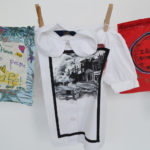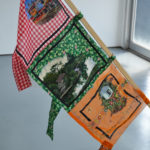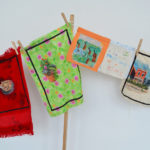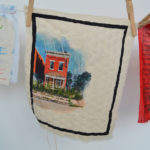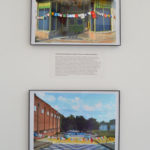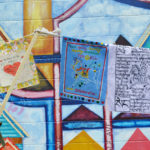Installation at the Paramount Building
Prayer Flags for Cincinnati Acrylic on found fabrics 2017Built in 1931 on the site of the first Joseph R. Peebles’ Sons Co. grocery store, the Paramount Building has evolved over time, in the past housing Will’s Loan & Jewelry, McDevitt Menswear and originally upon it’s construction, the Paramount Theater. The Peebles’ corner intersection historically served as a key cross-town transit transfer point in the city and locals described it as a gathering place of people from all over the city. The building has been abandoned for a number of years, but there have been many efforts to protect and maintain the beloved structure. Keep Cincinnati Beautiful volunteers painted designs on doors and windows in addition to installing plywood barricades to the structure and there are currently efforts by Walnut Hills Redevelopment Foundation to fundraise for its restoration. I witnessed the building’s function as a center point of the community while hanging the flags as many community members approached me to assist with the hanging and reminiscing about their memories of the site.
Prayer Flags for Cincinnati was a collaborative project featuring the perspectives and input of local Cincinnati residents which inspired both the themes and images of the flags created as well as their locations of installation. The homemade flags are modeled after Tibetan prayer flags, traditionally hung around homes, villages, and sacred sites and are believed to ward off evil spirits and bring luck to those touched by the winds that pass through the flags. Instead of using the traditional dyed cottons and mass woodblock printing, the flags are made out of the scraps of everyday life, including clothing, doilies, handkerchiefs, napkins, tablecloths, pillowcases and curtains. Images of Cincinnati’s triumphs, the dreams of its residents and most importantly, the toughest of its struggles are hand-painted onto each fabric flag. These experiences are literalized through hand-painted imagery, emerging from the cloth as either prideful adornment or through the form of a stain on the surface of the fabric.






























